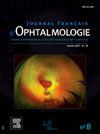Modalités évaluatives des connaissances et des compétences en orthoptie en France : où en sommes-nous dans l’application de l’Arrêté du 20 octobre 2014 ?
IF 1.1
4区 医学
Q3 OPHTHALMOLOGY
引用次数: 0
Abstract
Introduction
L’Arrêté du 20 octobre 2014 a structuré la formation des orthoptistes en France selon le modèle universitaire Licence-Master-Doctorat (LMD), visant à uniformiser la formation entre les départements de formation. Cette étude évalue, dix ans après sa publication, l’application réelle des modalités évaluatives de cet arrêté.
Méthodes
Cette étude rétrospective multicentrique a été menée auprès des 16 départements français d’orthoptie pour l’année universitaire 2023–2024. Les modalités générales de contrôle des connaissances et des compétences (M3C) ont été recueillies, analysant les modalités d’évaluation des unités d’enseignement (UE), du certificat de compétences cliniques (CCC) ainsi que la répartition des crédits ECTS.
Résultats
Douze départements ont participé. Les modalités évaluatives recommandées par l’arrêté sont globalement respectées, surtout concernant les examens écrits terminaux (94 %) et le contrôle continu (86 %). Cependant, la conformité des épreuves terminales orales reste faible (14 %). Concernant le CCC, des disparités notables existent, certains départements adoptant des évaluations structurées comme les ECOS (examens cliniques objectifs et structurés), tandis que d’autres n’ont pas formalisé cette évaluation. La majorité des départements respecte la répartition des crédits ECTS par semestre, mais des divergences subsistent pour l’allocation précise des crédits par UE.
Conclusion
Dix ans après la publication de l’arrêté de 2014, une bonne conformité générale est observée dans la formation en orthoptie aux recommandations évaluatives, malgré des disparités importantes, notamment pour les évaluations orales et le CCC. Une harmonisation accrue reste nécessaire pour garantir la qualité uniforme de la formation en orthoptie.
Introduction
The Order of October 20, 2014, structured ophthalmic technician training in France according to the university model, Licence-Master-Doctorat (LMD), aiming to standardize education across departments. This study evaluates the practical implementation of the assessment modalities specified in the order ten years after its publication.
Methods
A retrospective multicentric study was conducted in the 16 French ophthalmic technician training departments during the academic year 2023–2024. General Modalities for the Assessment of Knowledge and Skills (M3C) were collected, analyzing evaluation methods for teaching units (UE), the Clinical Competence Certificate (CCC), and the distribution of ECTS credits.
Results
Twelve departments participated. The evaluation methods recommended by the order were generally well followed, particularly regarding written final exams (94%) and continuous assessment (86%). However, oral final exams showed low conformity (14%). Regarding the CCC, significant disparities were observed, with some departments implementing structured evaluations such as OSCEs (Objective Structured Clinical Examinations), while others have not formalized this evaluation. Most departments comply with the distribution of ECTS credits per semester, but discrepancies persist in the precise allocation of credits per UE.
Conclusion
Ten years after the 2014 Order, ophthalmic technician training shows overall good conformity with evaluation recommendations, but with some notable disparities, particularly in oral assessments and CCC evaluations. Greater homogenization remains necessary to ensure consistent quality in ophthalmic technician training.
评估法国骨科知识和技能的方法:2014年10月20日法令的实施进展如何?
2014年10月20日颁布的法令将法国的矫形医生培训结构为基于大学模式的学士-硕士-博士(LMD),旨在使各培训部门之间的培训标准化。本研究评估了该命令的评估条款在发布10年后的实际应用情况。方法这项多中心回顾性研究在2023 - 2024学年对法国16个矫形系进行。通过分析教学单位(EU)、临床能力证书(CCC)的评估方法和ECTS学分的分配,收集了知识和技能测试(M3C)的一般程序。共有12个部门参与。该命令建议的评估程序在很大程度上得到了遵守,特别是在期末笔试(94%)和持续监测(86%)方面。然而,口服终末期试验的合规性仍然很低(14%)。在CCC方面存在显著差异,一些部门采用了结构化评估,如ECOS(客观和结构化临床试验),而另一些部门没有将这种评估正式化。大多数部门尊重ECTS学分每学期的分配,但在欧盟学分的精确分配方面存在分歧。结论2014年命令发布10年后,尽管在口头评估和CCC等方面存在显著差异,但骨科培训总体上符合评估建议的情况良好。进一步的协调仍然是必要的,以确保矫形培训的统一质量。2014年10月20日,法国根据大学模式、学士-硕士-博士(LMD)结构眼科技术人员培训,目的是使各院系的教育标准化。本研究评估了在出版后十年中规定的评估模式的实际实施情况。方法:一项回顾性多中心研究在2023 - 2024学年期间在16个法国眼科技术培训部门进行。本课程的目的是为学生提供一个机会,让他们在学习过程中获得更多的知识和技能。结果是12个部门参与。该命令推荐的评估方法总体上得到了很好的遵循,特别是笔试期末考试(94%)和持续评估(86%)。然而,口试的合规性很低(14%)。在CCC方面,观察到显著的差异,一些部门实施了结构化评估,如OSCEs(客观结构化临床检查),而另一些部门没有将这种评估正式化。在这门课程中,学生将学习英语、法语、西班牙语、西班牙语、葡萄牙语、葡萄牙语、葡萄牙语、葡萄牙语、葡萄牙语、葡萄牙语、葡萄牙语、葡萄牙语、葡萄牙语、葡萄牙语、葡萄牙语和葡萄牙语。结论:在2014年命令发布10年后,眼科技术人员培训显示总体上良好地符合评估建议,但有一些显著的差异,特别是在口头评估和CCC评估方面。进一步的同质化仍然是必要的,以确保眼科技术人员培训的一致质量。
本文章由计算机程序翻译,如有差异,请以英文原文为准。
求助全文
约1分钟内获得全文
求助全文
来源期刊
CiteScore
1.10
自引率
8.30%
发文量
317
审稿时长
49 days
期刊介绍:
The Journal français d''ophtalmologie, official publication of the French Society of Ophthalmology, serves the French Speaking Community by publishing excellent research articles, communications of the French Society of Ophthalmology, in-depth reviews, position papers, letters received by the editor and a rich image bank in each issue. The scientific quality is guaranteed through unbiased peer-review, and the journal is member of the Committee of Publication Ethics (COPE). The editors strongly discourage editorial misconduct and in particular if duplicative text from published sources is identified without proper citation, the submission will not be considered for peer review and returned to the authors or immediately rejected.

 求助内容:
求助内容: 应助结果提醒方式:
应助结果提醒方式:


